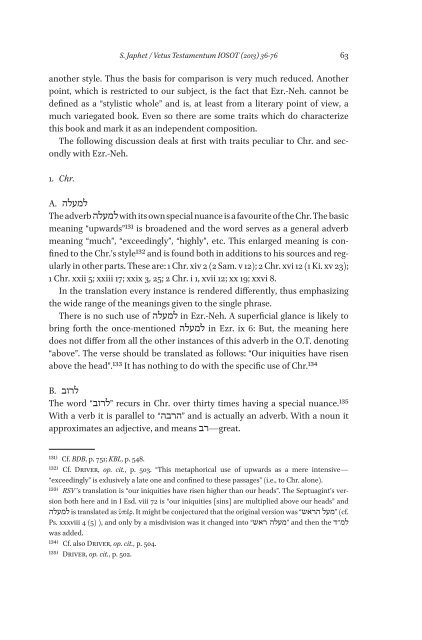Special Issue IOSOT 2013 - Books and Journals
Special Issue IOSOT 2013 - Books and Journals
Special Issue IOSOT 2013 - Books and Journals
You also want an ePaper? Increase the reach of your titles
YUMPU automatically turns print PDFs into web optimized ePapers that Google loves.
S. Japhet / Vetus Testamentum <strong>IOSOT</strong> (<strong>2013</strong>) 36-76 63<br />
another style. Thus the basis for comparison is very much reduced. Another<br />
point, which is restricted to our subject, is the fact that Ezr.-Neh. cannot be<br />
defined as a “stylistic whole” <strong>and</strong> is, at least from a literary point of view, a<br />
much variegated book. Even so there are some traits which do characterize<br />
this book <strong>and</strong> mark it as an independent composition.<br />
The following discussion deals at first with traits peculiar to Chr. <strong>and</strong> secondly<br />
with Ezr.-Neh.<br />
1. Chr.<br />
למעלה .A<br />
The adverb למעלה with its own special nuance is a favourite of the Chr. The basic<br />
meaning “upwards”131 is broadened <strong>and</strong> the word serves as a general adverb<br />
meaning “much”, “exceedingly”, “highly”, etc. This enlarged meaning is confined<br />
to the Chr.’s style132 <strong>and</strong> is found both in additions to his sources <strong>and</strong> regularly<br />
in other parts. These are: 1 Chr. xiv 2 (2 Sam. v 12); 2 Chr. xvi 12 (1 Ki. xv 23);<br />
1 Chr. xxii 5; xxiii 17; xxix 3, 25; 2 Chr. i 1, xvii 12; xx 19; xxvi 8.<br />
In the translation every instance is rendered differently, thus emphasizing<br />
the wide range of the meanings given to the single phrase.<br />
There is no such use of למעלה in Ezr.-Neh. A superficial glance is likely to<br />
bring forth the once-mentioned למעלה in Ezr. ix 6: But, the meaning here<br />
does not differ from all the other instances of this adverb in the O.T. denoting<br />
“above”. The verse should be translated as follows: “Our iniquities have risen<br />
above the head”.133 It has nothing to do with the specific use of Chr.134<br />
לרוב .B<br />
The word ”לרוב“ recurs in Chr. over thirty times having a special nuance.135<br />
With a verb it is parallel to ”הרבה“ <strong>and</strong> is actually an adverb. With a noun it<br />
approximates an adjective, <strong>and</strong> means .great—רב<br />
131) Cf. BDB, p. 751; KBL, p. 548.<br />
132) Cf. Driver, op. cit., p. 503. “This metaphorical use of upwards as a mere intensive—<br />
“exceedingly” is exlusively a late one <strong>and</strong> confined to these passages” (i.e., to Chr. alone).<br />
133) RSV ’s translation is “our iniquities have risen higher than our heads”. The Septuagint’s version<br />
both here <strong>and</strong> in I Esd. viii 72 is “our iniquities [sins] are multiplied above our heads” <strong>and</strong><br />
(cf. ”מעל הראש“ is translated as ὑπέρ. It might be conjectured that the original version was למעלה<br />
למ״ד <strong>and</strong> then the ”מעלה ראש“ Ps. xxxviii 4 (5) ), <strong>and</strong> only by a misdivision was it changed into<br />
was added.<br />
134) Cf. also Driver, op. cit., p. 504.<br />
135) Driver, op. cit., p. 502.








![Am HaSefer [Volk des Buches] - Books and Journals](https://img.yumpu.com/20648352/1/174x260/am-hasefer-volk-des-buches-books-and-journals.jpg?quality=85)







